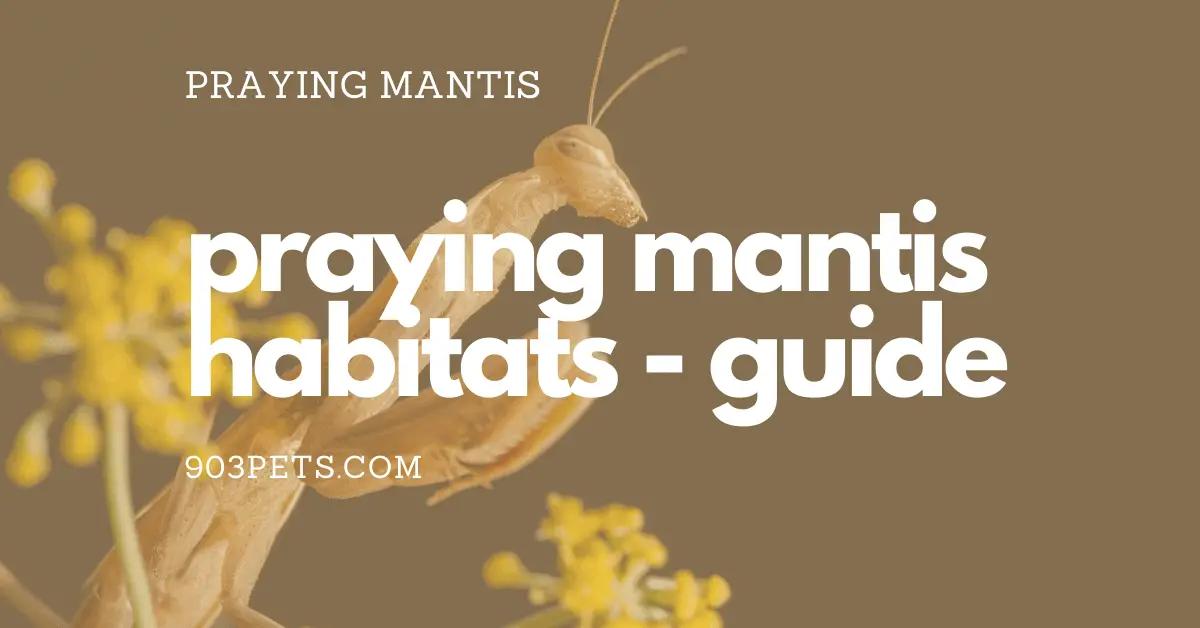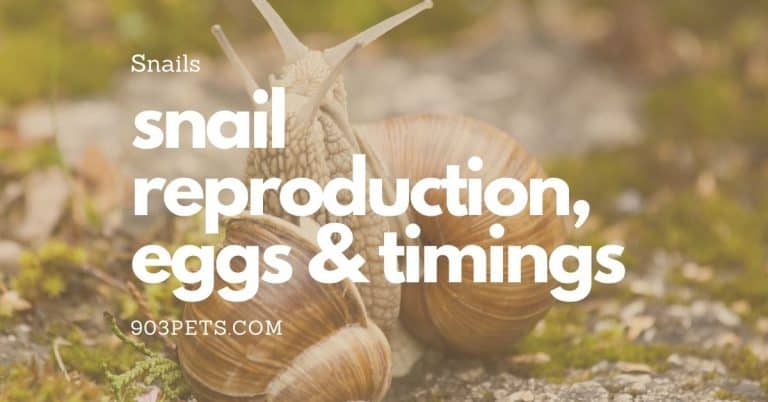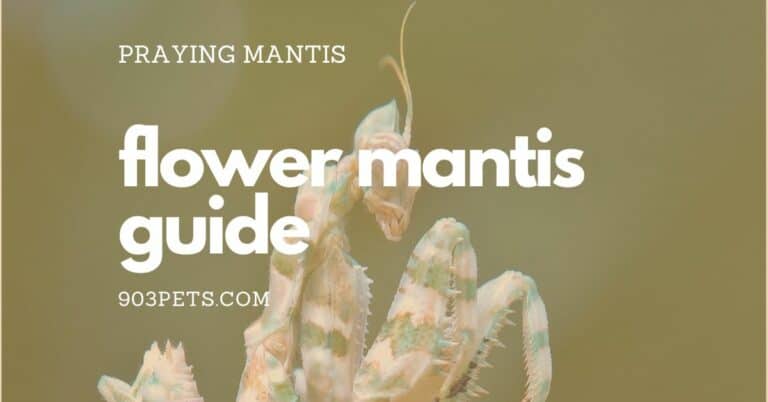Praying Mantis Habitat Guide – What Matters & What Doesn’t
If you’re interested in keeping praying mantises as pets, you’ll need to provide them with a suitable habitat. In this guide, we’ll cover what matters and what doesn’t when it comes to creating a praying mantis habitat. We’ll also provide some tips on how to keep your pet mantis healthy and happy.
Read on to learn everything you need to know about selecting and creating the perfect praying mantis habitat.
Parts That Make Up A Praying Mantis Enclosure
Generally, praying mantis enclosures require 7 functional considerations: materials, lid, substrate, vertical climbing, ventilation, environmental control, and water.

Let’s look at each component and determine if it is important in selecting your praying mantis habitat.
- Cage Material – Mantis cages are typically made of a material that allows visibility of the mantis. These materials include plastics, glass, and screens (wire cloth). Each material has characteristics that affect the mantis.
- Lid – The lid should be made of mesh or other permeable openings that allow for airflow. However, you’ll need to consider the mantises food source. The holes for airflow should be small enough that the mantis prey cannot escape. So, fruit flies require a finer mesh than large mantises eating crickets.
- Substrate – Substrates are what you place on the floor of the enclosure. These materials can range from newspaper, which can easily mold, to artificial mosses or soil. Substrates should be able to help hold some moisture to meet your mantis species’ humidity levels.
- Vertical Climbing – Vertical climbing areas are an absolute necessity for proper mantis care. Not all species can climb glass or plastic surfaces so you need to include opportunities to climb all the way to the top mesh lid. This can be found in the form of a branch, a vine, or cork bark. Braches with a “Y” shape are great.
- Ventilation – Ventilation is important because mantises are very sensitive to low humidity and high temperatures. Keeping good airflow is also important to prevent a build-up of bacteria, molds and fungi.
- Environmental Control – Temperature and humidity should be closely monitored, and the enclosure should have a thermometer and hygrometer. Mantis death is most common when too little moisture is available during molting.
- Water – Mantises do drink water, but not the way you might think. lightly misting the environment may be all that is needed. If keeping high enough humidity is difficult, consider keeping water in a shallow water dish. Place gravel in the dish to prevent drowning.
Types of Praying Mantis Habitats
Jars
Jars are an affordable way to keep a praying mantis, but they have their drawbacks.
Jars are limited in how much climbing surface they can provide. In fact, some species of mantids cannot climb on glass at all. This means including branches and other vertical climbing opportunities is critical. There should always be a branch that reaches the top mesh lid.
Jars are very easy to clean, and they provide a full view of the mantid. However, jars are poorly ventilated. The lid should be made of mesh to allow for airflow, and the jar should be at least three times the length of the mantis.
A clear jar, or one with a clear lid, is a great way to observe a mantis. Jars make it easy to keep a mantis in a dorm room or other small space.
Net Cages (Enclosures)
Net cages are a great option for mantises. The mesh is usually made of nylon, PVC or polyester screen. The durability depends on the manufacturer. Generally, net cages have the best airflow which can make it difficult to maintain the right humidity levels depending on the natural humidity levels of your home. However, they make daily misting a breeze.
There are typically two types of net cages, lightweight collapsible versions and metal rectangular screened cages. The collapsible versions tend to allow a full seal that prevents escape of smaller mantids while the metal cages tend to be better for larger adult species given manufacturing gaps after assembly.
The mesh in these habitats is also more difficult to clean because it is difficult to reach all parts of the mesh. To make cleaning easier, some manufacturers use a waterproof material on the bottom (floor) of the habitat. Some net cages are collapsable, which is a great feature when they are not in use.
There are versions that have a clear plastic material on one or two sides which gives a better viewing opportunity of your mantids.
Commercially, the two versions we have experience with are the Zoo Med Labs Nano Breeze Alumuninum Screen Cage for use with large adult mantises and the RESTCLOUD Insect and Butterfly Habitat Cage for all others.
Glass Enclosures (Aquariums/Vivariums)
Glass aquariums are a popular choice and can make a great mantis habitat but you’ll need to do some extra planning.
First, aquariums are typically wider than tall. We need them to be taller than wide for mantis as we are recreating the vertical climbing space they need.
Like jars, the smooth surfaces of aquariums will prevent some species of mantis from being able to climb. This means you will need to provide plenty of branches or other climbing opportunities that reach to the top of the lid.
Mantises need to reach the lid because they hang upside-down while molting. If your lid is not mesh, you can use a burlap ribbon, or screen, secured to the lid as a place for your mantis to hold while molting.
Remember that glass is not gas-permeable, meaning it does not allow air to flow through it. That’s why a mesh lid is necessary. In some cases, a miniature USB fan may be needed to keep good airflow.
On the plus side, aquariums are easy to clean because they have smooth surfaces and you can include lighting to put your mantis friend on full display.
Plastic Tubs & Containers
Plastic tubs and containers are a cost-effective and simple way to keep a mantis.
The primary concern is the height of the container. Remember that praying mantises are arboreal and need the ability to climb at least 3-4 times taller than they are long. A branch that reaches from bottom to top of the container is also needed.
Another consideration is the integrity of the tub. It should be made from sturdy material that is not easily broken. It should also seal well so the mantid cannot escape.
A mesh lid is a complete necessity to allow for airflow and as a place to hold as they molt upside-down. For larger containers having a mesh ventilation hole at the lower part of one side and a higher part on the opposite side can aid airflow.
Other decorations are a matter of personal preference. They are not required to keep a mantis happy and healthy.
Josh’s Frog’s has 32 oz. deli cups with a fabric lid that some folks use for small mantises with success. The one drawback is causing an “earthquake” for your mantis every time you open it. US Mantis solves this by selling a 32oz deli cup with a hole in the center and foam plugs to fill the hole between feedings and mistings.
Location – Where To Keep Your Praying Mantis Enclosure
Praying Mantis habitats can be kept anywhere indoors. But, there are a few considerations when finding just the right spot.
- Sunlight: Praying Mantises light to see. If a praying mantis enclosure is in direct sunlight, it will overheat and die. So, find a spot where there is daylight, but not direct sunlight during the entire day.
- Temperature: A praying mantis enclosure should be at a comfortable room temperature. If the praying mantis enclosure is too hot, it will get stressed and die. If the praying mantis enclosure is too cold, it will get sick and die. Check your specific species’ needs but typically a temperature of 72-78 F (22-26 C). For example, a spiny flower mantis may like temperatures of 80 F.
- Temperature Night Cycle: Praying Mantises need a warm day and a cool night. A praying mantis enclosure should not be kept in a place where it is always. Use a thermometer to measure the temperature inside the habitat.
- Humidity: Praying Mantises need humidity. A praying mantis enclosure should be kept in a place with a good amount of humidity. If the praying mantis enclosure is in a dry place, it may die from a failure to molt properly. Spiny flower mantises like humidity levels of 40-60%. Use a hygrometer to measure the humidity in the enclosure.
- Safe Surface: Having a safe surface for a praying mantis enclosure is important. Be sure the surface is sturdy and is not prone to tipping over. Also, ensure the surface is not susceptible to moisture. You’ll be misting your mantis habitat once or twice per day and it will get on the surface the habitat is on.
- Viewing: This is what it’s about, being able to see and enjoy your praying mantis. If the praying mantis enclosure is in a dark place you won’t be able to enjoy it regularly during their short lives.
- Access: It is important to be able to get to the praying mantis enclosure as you’ll be interacting with it at least once or twice per day. If the praying mantis enclosure is in a place where you can’t get to it, the praying mantis may not get the best care it needs. Make it easy on you and place it in a convenient location.
Size – How Big Does A Praying Mantis Enclosure Need To Be?

The size of your enclosure is going to depend on the size of the praying mantis. A typical enclosure for one mantis at a time is 12″ W x 10″ L x 18″ H.
When you’re deciding how big your enclosure should be, first you need to think about what size the praying mantis is going to be. The general rule of thumb is that a typical enclosure for a mantis must be three times the mantis’ length tall and two times it’s length wide.
So, for a praying mantis that will be 3″ long, the enclosure should be a minimum of 6″ W x 6″ L x 9″ H.
Substrates – What goes on the floor?
The substrate in your praying mantis enclosure serves two purposes, moisture, and poop. Yup, that’s right. Praying mantis poop, called frass, is a thing and if you use a white or light-colored substrate you’ll quickly notice it. Frass should be removed over time.
On the moisture front, substrates can help or harm your ability to maintain correct humidity levels. You want a substrate that is absorbent so it can retain moisture for short periods and allow it to evaporate back into the enclosure over time. This keeps the humidity levels up. But beware, some substrates will absorb water but then before to break down and mold quickly.
Let’s look at the most common substrates used in praying mantis habitats.
Coconut Coir: Coconut coir is a type of substrate that works well for praying mantises. It is made from coconut husks and is very absorbent which helps maintain humidity levels well and does a great job of not becoming moldy. Coconut coir is also a good substrate because it can be easily and cheaply obtained at pet stores or online. In fact, this is our top choice of substrate for mantis habitats.
Mosses: Moss can work as a great living substrate for praying mantises, but it needs to be monitored regularly to ensure it no fungus begins growing. Reptile mosses are available in pet stores, some plant shops, and of course, Amazon. It is inexpensive and looks really nice for a natural feel.
Artificial Moss: Artificial moss is often used in terrariums and flower arrangements, and it’s a great substrate for praying mantises. You can find this material in a variety of colors which can make for a colorful display. Keep in mind that it will lose its artificial color over time and need to be replaced, but it is still a great option for an inexpensive, pretty substrate.
Sterilized Soil: Soil can be the least expensive substrate for a praying mantis habitat. But, you need to ensure the soil is fertilizer and pesticide-free and it must be free of “bad” things that could harm your mantis. That’s why we recommend sterilizing any soil used for the substrate. See our soil sterilization article. As long as the soil is sterilized, it can be a great [rimary substrate for praying mantises.
Paper Towels or Newspaper: Paper towels or newspaper can be an okay substrate for a praying mantis habitat, but it is not our top choice. That said, it is an inexpensive way to cover the floor of the habitat and it is easy to change out if it becomes moldy from the mantis misting and eating. Honestly, it’s just not pretty and you’ll need to change it out often.
Sand: Sand may work as a substrate for praying mantises, but it is also not our top choice. If you choose to use sand, be sure to wash it until the water runs clear. You’ll be able to more easily see mantis frass and can simply scoop the sand out and wash it to remove the frass on occasion. Because sand is not really porous, it does not hold water, you will need a thicker layer of sand to trap water between the particles of sand. We generally say 1″ of sand should do the trick. If your water is evaporating too quickly, make the sand deeper.
Gravel: Gravel is not a good substrate for praying mantises. There are better alternatives above. Why? Well, it does not hold moisture which means humidity is difficult to maintain. Gravel also traps and hides mantis frass which is not ideal. This can lead to the growth of mold or bacteria which can be detrimental to your mantis.
As a general rule, coconut coir (husk) or EcoEarth are the best substrates for praying mantises. They are absorbent and do not mold easily. They are also economical and easily obtained online or in local pet stores.
Decorations – Required vs. Aesthetics

Decorations are important for praying mantis setups because they are used to create a natural-looking environment for your pet. This can be as simple as adding some sticks and leaves, or as complex as making a garden-like habitat. Be creative!
So, what’s required? That’s pretty simple as there are two things you must have, a climbing path to the top and a place to hang at the top.
Since praying mantises are arboreal, they are natural climbers. In fact, they require the ability to climb. The simplest solution is to find some tree branches with a couple of forks or Y’s in them and cut them to size. Be sure they are secure and will not fall on the mantis as this could cause severe injury.
The branches must reach from the bottom of the enclosure, all the way to the top lid as they become the ladder that the mantis climbs when it is time to molt.
Remember that our lovely praying mantis pets have an exoskeleton and molt several times in their life to remove the old exoskeleton and reveal the new, bigger exoskeleton they inhabit. They do this by climbing to the top of the enclosure and then hanging upside-down to molt. That is why there needs to be some type of mesh material at the top of the enclosure from which the mantis can easily hang for days.
If your enclosure does not have this, you can easily secure rows of burlap with a hot glue gun to cover the lid surface. Burlap ribbon is very inexpensive and can be found at most fabric stores. Alternatively, you can use sections of the screen from a window. Just remember not to impede airflow.
Any other decorations are purely aesthetic, but they can help to make your pet feel at home and showcase their majesty. Just be sure they are made from materials that are safe for your mantis.
Wrap Up
Praying mantis enclosures require 7 functional considerations: materials, lid, substrate, vertical climbing, ventilation, environmental control, and water. The size of your enclosure is going to depend on the size of the praying mantis. A typical enclosure for one mantis at a time is 12″ W x 10″ L x 18″ H depending on the species.
The substrate in your praying mantis enclosure serves two purposes, moisture, and frass which should be removed over time. Choosing the right substrates can assist your ability to maintain correct humidity levels.
We recommend coconut coir as the best substrate for praying mantises. It is absorbent and does not mold easily. It is also cheap and easily obtained.
There are two functional decorations you must have, a climbing path to the top and a place for your mantis to hang at the top.
Since praying mantises are arboreal, they are natural climbers. Adding tree branches, cut to size is the perfect solution. Be sure they are secure and will not fall on the mantis.
If you think your pet is ill, call a vet immediately. All health-related questions should be referred to your veterinarian. They can examine your pet, understand its health history, and make well informed recommendations for your pet.
903pets.com Staff



![Praying Mantis Egg Cases - Buyers Guide [Info & Tips] 6 Praying Mantis Egg Cases – Buyers Guide [Info & Tips]](https://cdn-0.903pets.com/ifywhoft/2022/05/praying-mantis-egg-cases-buyers-guide-768x402.jpg)
![Insect Pets - Which Insects Make The Best Pets? [12 Answers] 8 Insect Pets – Which Insects Make The Best Pets? [12 Answers]](https://cdn-0.903pets.com/ifywhoft/2022/01/insect-pets-are-they-right-for-you-768x402.jpg)


